 Technology peripherals
Technology peripherals
 AI
AI
 What did Tongji and Alibaba's CVPR 2022 Best Student Paper Awards study? This is an interpretation of one work
What did Tongji and Alibaba's CVPR 2022 Best Student Paper Awards study? This is an interpretation of one work
What did Tongji and Alibaba's CVPR 2022 Best Student Paper Awards study? This is an interpretation of one work
This article explains our work "EPro-PnP: Generalized End-to-End Probabilistic Perspective-n-Points for Monocular Object Pose Estimation" which won the CVPR 2022 Best Student Paper Award. The problem studied in this paper is to estimate the pose of an object in 3D space based on a single image. Among existing methods, pose estimation methods based on PnP geometric optimization often extract 2D-3D related points through deep networks. However, because the optimal solution of pose is not differentiable during backpropagation, it is difficult to use pose error as the The loss performs stable end-to-end training of the network, when the 2D-3D correlation points rely on the supervision of other agent losses, which is not an optimal training goal for pose estimation.
In order to solve this problem, we based on theory and proposed the EPro-PnP module, which outputs the probability density distribution of the pose instead of a single optimal solution of the pose, thus The non-differentiable optimal pose is replaced with a differentiable probability density, achieving stable end-to-end training. EPro-PnP is highly versatile and suitable for various specific tasks and data. It can be used to improve existing PnP-based pose estimation methods, or it can also use its flexibility to train new networks. In a more general sense, EPro-PnP essentially brings the common classification softmax into the continuous domain, and can theoretically be extended to train general models with nested optimization layers.

##Paper link: https://arxiv.org/abs/2203.13254
Code link: https://github.com/tjiiv-cprg/EPro-PnP
1. Preface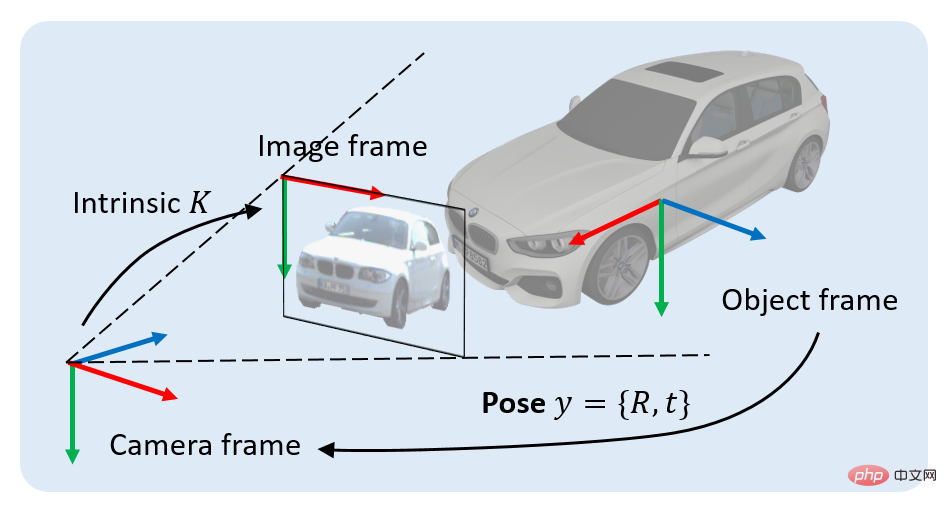
We study a classic problem in 3D vision: locating 3D objects based on a single RGB image. Specifically, given an image containing a projection of a 3D object, our goal is to determine the rigid body transformation from the object coordinate system to the camera coordinate system. This rigid body transformation is called the pose of the object, denoted as y, which contains two parts: 1) position component, which can be represented by a 3x1 displacement vector t, 2) orientation component, which can be represented by a 3x3 rotation matrix R means.
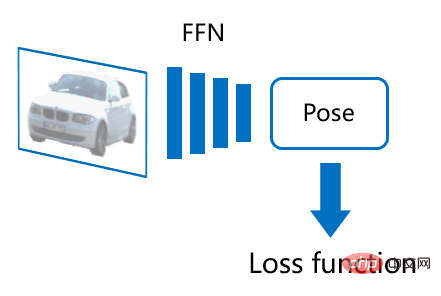
To address this problem, existing methods can be divided into two categories: explicit and implicit. The explicit method can also be called direct pose prediction, which uses a feedforward neural network (FFN) to directly output each component of the object's pose, usually: 1) Predict the object's pose Depth, 2) find out the 2D projection position of the object's center point on the image, 3) predict the object's orientation (the specific processing method of orientation may be more complicated). Using image data marked with the true pose of the object, a loss function can be designed to directly supervise the pose prediction results, easily achieving end-to-end training of the network. However, such networks lack interpretability and are prone to overfitting on smaller datasets. In 3D object detection tasks, explicit methods dominate, especially for larger datasets (such as nuScenes).
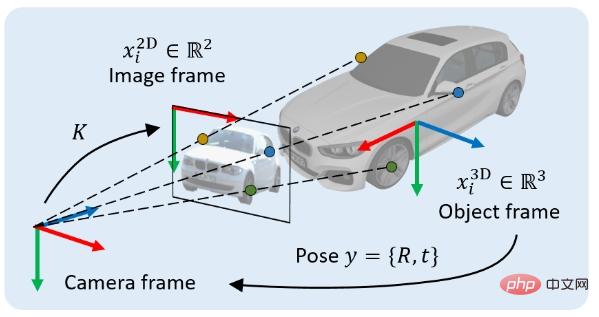

The implicit method is a pose estimation method based on geometric optimization. The most typical representative is the Pose estimation method based on PnP. In this type of method, you first need to find N 2D points in the image coordinate system (the 2D coordinates of the i-th point are marked  ), and at the same time find the associated points in the object coordinate system. N 3D points (the 3D coordinates of the i-th point are marked as
), and at the same time find the associated points in the object coordinate system. N 3D points (the 3D coordinates of the i-th point are marked as  ), and sometimes it is necessary to obtain the associated weight of each pair of points (the associated weight of the i-th pair of points is marked as
), and sometimes it is necessary to obtain the associated weight of each pair of points (the associated weight of the i-th pair of points is marked as  ). According to the perspective projection constraint, these N pairs of 2D-3D weighted associated points implicitly define the optimal pose of the object. Specifically, we can find the object pose that minimizes the reprojection error
). According to the perspective projection constraint, these N pairs of 2D-3D weighted associated points implicitly define the optimal pose of the object. Specifically, we can find the object pose that minimizes the reprojection error  :
:

where , represents the weighted reprojection error, which is the
, represents the weighted reprojection error, which is the  function of pose.
function of pose.  represents the camera projection function containing internal parameters,
represents the camera projection function containing internal parameters,  represents the element product. The PnP method is commonly used in 6-degree-of-freedom pose estimation tasks where the object geometry is known.
represents the element product. The PnP method is commonly used in 6-degree-of-freedom pose estimation tasks where the object geometry is known.

The PnP-based method also requires a feed-forward network to predict the 2D-3D associated point set . Compared with direct pose prediction, this deep learning model combined with traditional geometric vision algorithms has very good interpretability and its generalization performance is relatively stable. However, there are flaws in the model training methods in previous work. Many methods construct a proxy loss function to supervise the intermediate result X, which is not an optimal goal for pose. For example, if the shape of the object is known, the 3D key points of the object can be selected in advance, and then the network is trained to find the corresponding 2D projection point position. This also means that the surrogate loss can only learn some of the variables in X and is therefore not flexible enough. What if we don’t know the shapes of the objects in the training set and need to learn everything in X from scratch?
. Compared with direct pose prediction, this deep learning model combined with traditional geometric vision algorithms has very good interpretability and its generalization performance is relatively stable. However, there are flaws in the model training methods in previous work. Many methods construct a proxy loss function to supervise the intermediate result X, which is not an optimal goal for pose. For example, if the shape of the object is known, the 3D key points of the object can be selected in advance, and then the network is trained to find the corresponding 2D projection point position. This also means that the surrogate loss can only learn some of the variables in X and is therefore not flexible enough. What if we don’t know the shapes of the objects in the training set and need to learn everything in X from scratch?
The explicit and implicit methods have complementary advantages. If the network can be trained end-to-end to learn the associated point set X by supervising the pose results output by PnP, the two can be combined Combining advantages. To achieve this goal, some recent studies have implemented backpropagation of PnP layers using implicit function derivation. However, the argmin function in PnP is discontinuous and non-differentiable at certain points, making backpropagation unstable and direct training difficult to converge.
2. Introduction to EPro-PnP method
1. EPro-PnP module


In order to achieve stable end-to-end For training, we propose end-to-end probabilistic PnP (end-to-end probabilistic PnP), namely EPro-PnP. The basic idea is to regard the implicit pose as a probability distribution, then its probability density  is differentiable for X. First, define the likelihood function of the pose based on the reprojection error:
is differentiable for X. First, define the likelihood function of the pose based on the reprojection error:


If an uninformative prior is used, then the posterior of the pose The probability density is the normalized result of the likelihood function:


It can be noted that the above formula is consistent with the commonly used classification softmax formula points are close. In fact, the essence of EPro-PnP is to move the softmax from the discrete threshold to the continuous threshold, and replace the sum
points are close. In fact, the essence of EPro-PnP is to move the softmax from the discrete threshold to the continuous threshold, and replace the sum  with an integral
with an integral .
.
2. KL divergence loss
In the process of training the model, if the true pose of the object is known, it can be defined Target pose distribution
is known, it can be defined Target pose distribution . At this time, the KL divergence
. At this time, the KL divergence  can be calculated as the loss function used to train the network (because
can be calculated as the loss function used to train the network (because  is fixed, it can also be understood as the cross-entropy loss function). When the target
is fixed, it can also be understood as the cross-entropy loss function). When the target  approaches the Dirac function, the loss function based on KL divergence can be simplified to the following form:
approaches the Dirac function, the loss function based on KL divergence can be simplified to the following form:

If you want to derive its derivative:

It can be seen that the loss function consists of two items. The first item (denoted as  ) attempts to reduce the reprojection of the true value of the pose
) attempts to reduce the reprojection of the true value of the pose  Error, the second term (denoted as
Error, the second term (denoted as  ) attempts to increase the reprojection error everywhere in the predicted pose
) attempts to increase the reprojection error everywhere in the predicted pose  . The two directions are opposite, and the effect is shown in the figure below (left). As an analogy, the right side is the categorical cross-entropy loss that we commonly use when training classification networks.
. The two directions are opposite, and the effect is shown in the figure below (left). As an analogy, the right side is the categorical cross-entropy loss that we commonly use when training classification networks.
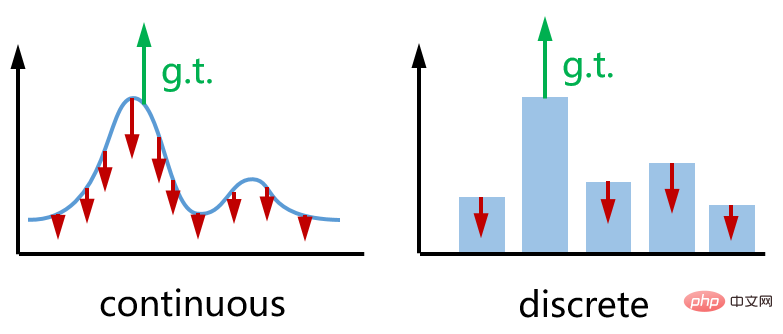
3. Monte Carlo pose loss
It should be noted that the second term in KL loss contains an integral. This integral has no analytical solution, so it must be approximated by numerical methods. Considering versatility, accuracy and computational efficiency, we use the Monte Carlo method to simulate the pose distribution through sampling.
contains an integral. This integral has no analytical solution, so it must be approximated by numerical methods. Considering versatility, accuracy and computational efficiency, we use the Monte Carlo method to simulate the pose distribution through sampling.

Specifically, we used an importance sampling algorithm-Adaptive Multiple Importance Sampling (AMIS) to calculate K The pose sample  with weight
with weight  , we call this process Monte Carlo PnP:
, we call this process Monte Carlo PnP:

According to this, the second term  can be approximated as a function about the weight
can be approximated as a function about the weight  , and
, and  can Back propagation:
can Back propagation:

The visualization effect of pose sampling is as shown below:

4. Derivative regularization for PnP solver
Although Monte Carlo PnP loss can be used to train the network to obtain high-quality pose distribution, in the inference stage, PnP is still needed Optimize the solver to get the optimal pose solution . The commonly used Gauss-Newton algorithm and its derivatives solve
. The commonly used Gauss-Newton algorithm and its derivatives solve  through iterative optimization, and its iterative increment is determined by the first-order and second-order derivatives of the cost function
through iterative optimization, and its iterative increment is determined by the first-order and second-order derivatives of the cost function  . To make the solution of PnP
. To make the solution of PnP  closer to the true value
closer to the true value  , the derivative of the cost function can be regularized. The regularization loss function is designed as follows:
, the derivative of the cost function can be regularized. The regularization loss function is designed as follows:

Among them,  is the Gauss-Newton iteration increment, and the cost function The first-order and second-order derivatives are related and can be backpropagated.
is the Gauss-Newton iteration increment, and the cost function The first-order and second-order derivatives are related and can be backpropagated.  represents the distance metric, using smooth L1 for position and cosine similarity for orientation. When
represents the distance metric, using smooth L1 for position and cosine similarity for orientation. When  is inconsistent, this loss function causes the iteration increment
is inconsistent, this loss function causes the iteration increment  to point to the actual true value.
to point to the actual true value.
3. Pose estimation network based on EPro-PnP
We use different subtasks for the 6-degree-of-freedom pose estimation and 3D target detection. network. Among them, for 6-degree-of-freedom pose estimation, it is slightly modified based on the CDPN network of ICCV 2019 and trained with EPro-PnP to conduct ablation studies; for 3D target detection, a brand-new network is designed based on the FCOS3D of ICCVW 2021. Deformable correspondence detection head to prove that EPro-PnP can train the network to directly learn all 2D-3D points and association weights without object shape knowledge, thus demonstrating the flexibility of EPro-PnP in applications.
1. Dense correlation network for 6-DOF pose estimation
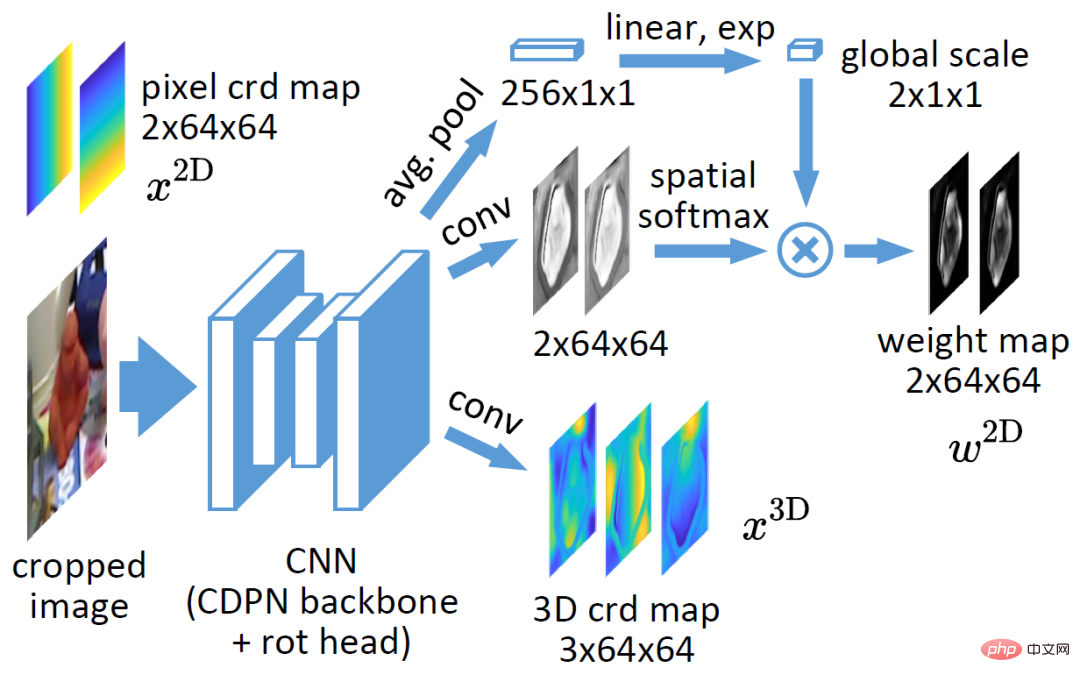
The network structure is shown in the figure above, except that the output layer is modified based on the original CDPN. The original CDPN uses the detected object 2D box to crop out the regional image and inputs it into the ResNet34 backbone. The original CDPN decouples position and orientation into two branches. The position branch uses the explicit method of direct prediction, while the orientation branch uses the implicit method of dense association and PnP. In order to study EPro-PnP, the modified network only retains the dense correlation branch, whose output is a 3-channel 3D coordinate map, and a 2-channel correlation weight, where the correlation weight has undergone spatial softmax and global weight scaling. The purpose of adding spatial softmax is to normalize the weight  so that it has properties similar to attention map and can focus on relatively important areas. Experiments have proved that weight normalization is also the key to stable convergence. Global weight scaling reflects the concentration of pose distribution
so that it has properties similar to attention map and can focus on relatively important areas. Experiments have proved that weight normalization is also the key to stable convergence. Global weight scaling reflects the concentration of pose distribution . The network can be trained with only the Monte Carlo pose loss of EPro-PnP, in addition to adding derivative regularization and an additional 3D coordinate regression loss when the object shape is known.
. The network can be trained with only the Monte Carlo pose loss of EPro-PnP, in addition to adding derivative regularization and an additional 3D coordinate regression loss when the object shape is known.
2. Deformation correlation network for 3D target detection

The network structure is shown in the figure above. Generally speaking, it is based on the FCOS3D detector and refers to the network structure designed by deformable DETR. Based on FCOS3D, its centerness and classification layers are retained, and its original pose prediction layer is replaced by object embedding and reference point layers for generating object query. Referring to deformable DETR, we get the 2D sampling position by predicting the offset relative to the reference point (so we get  ). The sampled features are aggregated into object features through attention operations, which are used to predict object-level results (3D score, weight scale, 3D box size, etc.). In addition, after sampling, the features of each point are added with object embedding and processed by self attention to output the 3D coordinates
). The sampled features are aggregated into object features through attention operations, which are used to predict object-level results (3D score, weight scale, 3D box size, etc.). In addition, after sampling, the features of each point are added with object embedding and processed by self attention to output the 3D coordinates  and associated weights
and associated weights  corresponding to each point. All the predicted
corresponding to each point. All the predicted  can be obtained by the Monte Carlo pose loss training of EPro-PnP, which can converge and achieve high accuracy without additional regularization. On this basis, derivative regularization loss and auxiliary loss can be added to further improve accuracy.
can be obtained by the Monte Carlo pose loss training of EPro-PnP, which can converge and achieve high accuracy without additional regularization. On this basis, derivative regularization loss and auxiliary loss can be added to further improve accuracy.
4. Experimental results
1. 6-degree-of-freedom pose estimation task
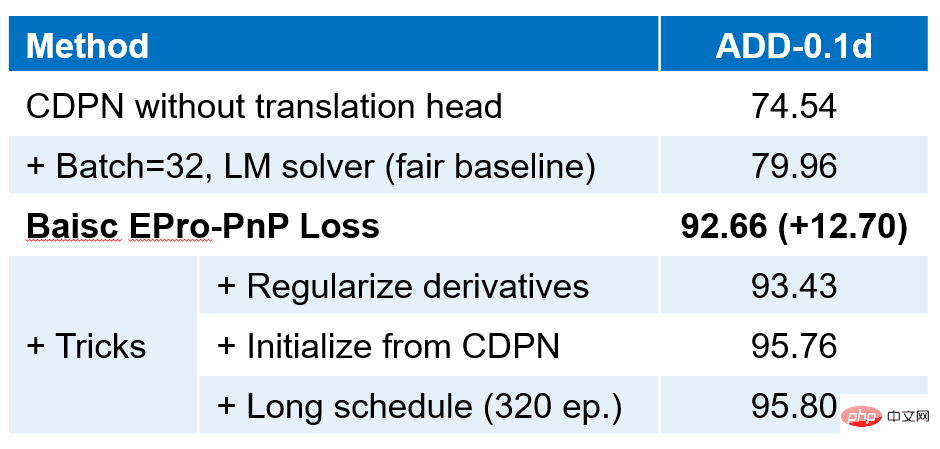
Using LineMOD data set Experiments and strict comparison with CDPN baseline, the main results are as above. It can be seen that by adding EPro-PnP loss for end-to-end training, the accuracy is significantly improved (12.70). Continue to increase the derivative regularization loss, and the accuracy is further improved. On this basis, using the training results of the original CDPN to initialize and increase epochs (keeping the total number of epochs consistent with the complete three-stage training of the original CDPN) can further improve the accuracy. Part of the advantage of pre-training CDPN comes from the additional training of CDPN. mask supervision.

The above figure is a comparison of EPro-PnP with various leading methods. EPro-PnP, which is improved from the backward CDPN, is close to SOTA in accuracy, and the architecture of EPro-PnP is simple. It is completely based on PnP for pose estimation and does not require additional explicit depth estimation or pose refinement. Therefore, in There are also advantages in efficiency.
2. 3D target detection task

Using the nuScenes data set experiment, the results compared with other methods are shown in the figure above. EPro-PnP not only has a significant improvement over FCOS3D, but also surpasses PGD, another improved version of SOTA and FCOS3D at the time. More importantly, EPro-PnP is currently the only one that uses geometric optimization methods to estimate pose on the nuScenes dataset. Due to the large scale of the nuScenes data set, the end-to-end trained direct pose estimation network already has good performance, and our results illustrate that end-to-end training of a model based on geometric optimization can achieve better performance on large data sets. Excellent performance.
3. Visual analysis
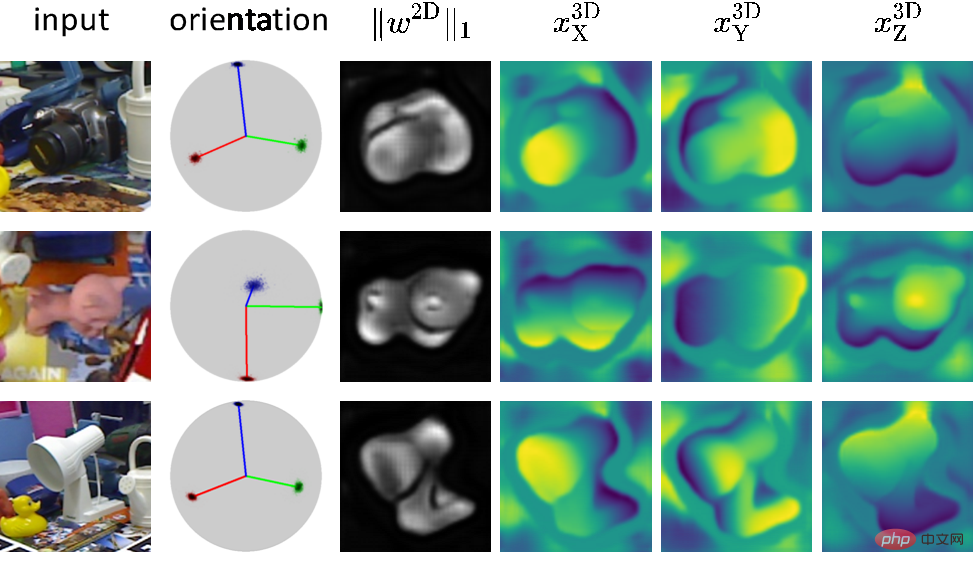
The above figure shows the prediction results of the dense association network trained with EPro-PnP. Among them, the correlation weightgraph highlights important areas in the image, similar to the attention mechanism. From the loss function analysis, it can be seen that the highlight area corresponds to the area with low reprojection uncertainty and which is more sensitive to pose changes.
highlights important areas in the image, similar to the attention mechanism. From the loss function analysis, it can be seen that the highlight area corresponds to the area with low reprojection uncertainty and which is more sensitive to pose changes.

#The results of 3D target detection are shown in the figure above. The upper left view shows the 2D point positions sampled by the deformation correlation network. Red indicates that the horizontal X component is higher, and green indicates that the vertical Y component is higher. High point. The green dots are generally located at the upper and lower ends of the object. Their main function is to calculate the distance of the object through the height of the object. This feature is not artificially specified and is completely the result of free training. The picture on the right shows the detection results in a top view, in which the blue cloud image represents the distribution density of the center point of the object, reflecting the uncertainty of the object's positioning. Generally, the positioning uncertainty of distant objects is greater than that of nearby objects. 
 Another important advantage of EPro-PnP is the ability to represent orientation ambiguity by predicting complex multimodal distributions. As shown in the figure above, Barrier often has two peaks with a difference of 180° due to the rotational symmetry of the object itself; Cone itself has no specific orientation, so the prediction results are distributed in all directions; Pedestrian is not completely rotationally symmetrical, but due to the image It's not clear, it's hard to tell the front and back, and sometimes there are two peaks. This probabilistic characteristic makes EPro-PnP do not require any special processing on the loss function for symmetric objects.
Another important advantage of EPro-PnP is the ability to represent orientation ambiguity by predicting complex multimodal distributions. As shown in the figure above, Barrier often has two peaks with a difference of 180° due to the rotational symmetry of the object itself; Cone itself has no specific orientation, so the prediction results are distributed in all directions; Pedestrian is not completely rotationally symmetrical, but due to the image It's not clear, it's hard to tell the front and back, and sometimes there are two peaks. This probabilistic characteristic makes EPro-PnP do not require any special processing on the loss function for symmetric objects.
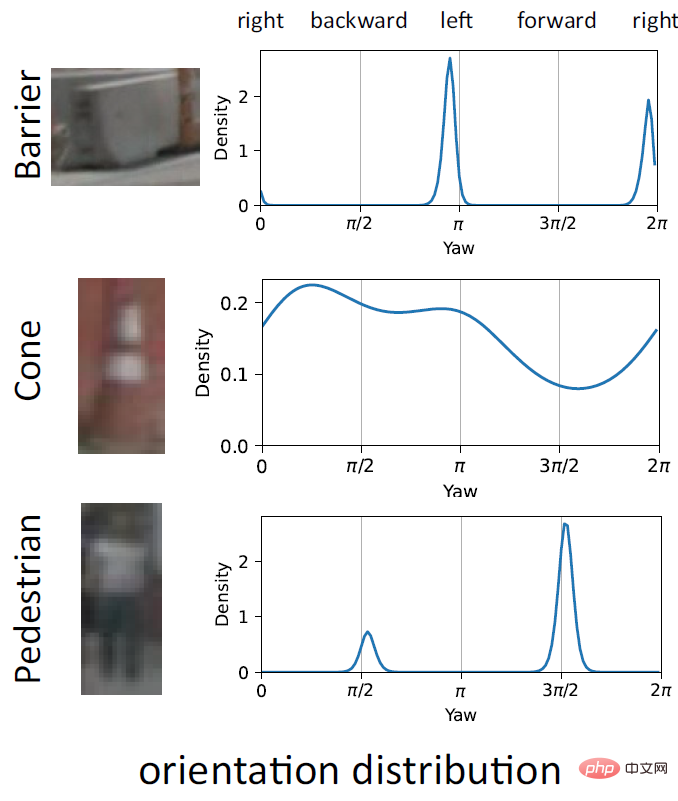 5. Summary
5. Summary
EPro-PnP transforms the originally undifferentiable optimal pose into a differentiable pose probability density, making the position based on PnP geometric optimization The pose estimation network enables stable and flexible end-to-end training. EPro-PnP can be applied to general 3D object pose estimation problems. Even when the 3D object geometry is unknown, the 2D-3D associated points of the object can be learned through end-to-end training. Therefore, EPro-PnP broadens the possibilities of network design, such as our proposed deformation correlation network, which was previously impossible to train.
In addition, EPro-PnP can also be directly used to improve existing PnP-based pose estimation methods, releasing the potential of existing networks through end-to-end training and improving pose estimation accuracy. In a more general sense, EPro-PnP essentially brings the common classification softmax into the continuous domain. It can not only be used for other 3D vision problems based on geometric optimization, but can also be theoretically extended to train general nested optimization layers. model.
The above is the detailed content of What did Tongji and Alibaba's CVPR 2022 Best Student Paper Awards study? This is an interpretation of one work. For more information, please follow other related articles on the PHP Chinese website!

Hot AI Tools

Undresser.AI Undress
AI-powered app for creating realistic nude photos

AI Clothes Remover
Online AI tool for removing clothes from photos.

Undress AI Tool
Undress images for free

Clothoff.io
AI clothes remover

Video Face Swap
Swap faces in any video effortlessly with our completely free AI face swap tool!

Hot Article

Hot Tools

Notepad++7.3.1
Easy-to-use and free code editor

SublimeText3 Chinese version
Chinese version, very easy to use

Zend Studio 13.0.1
Powerful PHP integrated development environment

Dreamweaver CS6
Visual web development tools

SublimeText3 Mac version
God-level code editing software (SublimeText3)

Hot Topics
 1664
1664
 14
14
 1423
1423
 52
52
 1317
1317
 25
25
 1268
1268
 29
29
 1242
1242
 24
24
 The world's most powerful open source MoE model is here, with Chinese capabilities comparable to GPT-4, and the price is only nearly one percent of GPT-4-Turbo
May 07, 2024 pm 04:13 PM
The world's most powerful open source MoE model is here, with Chinese capabilities comparable to GPT-4, and the price is only nearly one percent of GPT-4-Turbo
May 07, 2024 pm 04:13 PM
Imagine an artificial intelligence model that not only has the ability to surpass traditional computing, but also achieves more efficient performance at a lower cost. This is not science fiction, DeepSeek-V2[1], the world’s most powerful open source MoE model is here. DeepSeek-V2 is a powerful mixture of experts (MoE) language model with the characteristics of economical training and efficient inference. It consists of 236B parameters, 21B of which are used to activate each marker. Compared with DeepSeek67B, DeepSeek-V2 has stronger performance, while saving 42.5% of training costs, reducing KV cache by 93.3%, and increasing the maximum generation throughput to 5.76 times. DeepSeek is a company exploring general artificial intelligence
 AI subverts mathematical research! Fields Medal winner and Chinese-American mathematician led 11 top-ranked papers | Liked by Terence Tao
Apr 09, 2024 am 11:52 AM
AI subverts mathematical research! Fields Medal winner and Chinese-American mathematician led 11 top-ranked papers | Liked by Terence Tao
Apr 09, 2024 am 11:52 AM
AI is indeed changing mathematics. Recently, Tao Zhexuan, who has been paying close attention to this issue, forwarded the latest issue of "Bulletin of the American Mathematical Society" (Bulletin of the American Mathematical Society). Focusing on the topic "Will machines change mathematics?", many mathematicians expressed their opinions. The whole process was full of sparks, hardcore and exciting. The author has a strong lineup, including Fields Medal winner Akshay Venkatesh, Chinese mathematician Zheng Lejun, NYU computer scientist Ernest Davis and many other well-known scholars in the industry. The world of AI has changed dramatically. You know, many of these articles were submitted a year ago.
 Google is ecstatic: JAX performance surpasses Pytorch and TensorFlow! It may become the fastest choice for GPU inference training
Apr 01, 2024 pm 07:46 PM
Google is ecstatic: JAX performance surpasses Pytorch and TensorFlow! It may become the fastest choice for GPU inference training
Apr 01, 2024 pm 07:46 PM
The performance of JAX, promoted by Google, has surpassed that of Pytorch and TensorFlow in recent benchmark tests, ranking first in 7 indicators. And the test was not done on the TPU with the best JAX performance. Although among developers, Pytorch is still more popular than Tensorflow. But in the future, perhaps more large models will be trained and run based on the JAX platform. Models Recently, the Keras team benchmarked three backends (TensorFlow, JAX, PyTorch) with the native PyTorch implementation and Keras2 with TensorFlow. First, they select a set of mainstream
 Hello, electric Atlas! Boston Dynamics robot comes back to life, 180-degree weird moves scare Musk
Apr 18, 2024 pm 07:58 PM
Hello, electric Atlas! Boston Dynamics robot comes back to life, 180-degree weird moves scare Musk
Apr 18, 2024 pm 07:58 PM
Boston Dynamics Atlas officially enters the era of electric robots! Yesterday, the hydraulic Atlas just "tearfully" withdrew from the stage of history. Today, Boston Dynamics announced that the electric Atlas is on the job. It seems that in the field of commercial humanoid robots, Boston Dynamics is determined to compete with Tesla. After the new video was released, it had already been viewed by more than one million people in just ten hours. The old people leave and new roles appear. This is a historical necessity. There is no doubt that this year is the explosive year of humanoid robots. Netizens commented: The advancement of robots has made this year's opening ceremony look like a human, and the degree of freedom is far greater than that of humans. But is this really not a horror movie? At the beginning of the video, Atlas is lying calmly on the ground, seemingly on his back. What follows is jaw-dropping
 KAN, which replaces MLP, has been extended to convolution by open source projects
Jun 01, 2024 pm 10:03 PM
KAN, which replaces MLP, has been extended to convolution by open source projects
Jun 01, 2024 pm 10:03 PM
Earlier this month, researchers from MIT and other institutions proposed a very promising alternative to MLP - KAN. KAN outperforms MLP in terms of accuracy and interpretability. And it can outperform MLP running with a larger number of parameters with a very small number of parameters. For example, the authors stated that they used KAN to reproduce DeepMind's results with a smaller network and a higher degree of automation. Specifically, DeepMind's MLP has about 300,000 parameters, while KAN only has about 200 parameters. KAN has a strong mathematical foundation like MLP. MLP is based on the universal approximation theorem, while KAN is based on the Kolmogorov-Arnold representation theorem. As shown in the figure below, KAN has
 Tesla robots work in factories, Musk: The degree of freedom of hands will reach 22 this year!
May 06, 2024 pm 04:13 PM
Tesla robots work in factories, Musk: The degree of freedom of hands will reach 22 this year!
May 06, 2024 pm 04:13 PM
The latest video of Tesla's robot Optimus is released, and it can already work in the factory. At normal speed, it sorts batteries (Tesla's 4680 batteries) like this: The official also released what it looks like at 20x speed - on a small "workstation", picking and picking and picking: This time it is released One of the highlights of the video is that Optimus completes this work in the factory, completely autonomously, without human intervention throughout the process. And from the perspective of Optimus, it can also pick up and place the crooked battery, focusing on automatic error correction: Regarding Optimus's hand, NVIDIA scientist Jim Fan gave a high evaluation: Optimus's hand is the world's five-fingered robot. One of the most dexterous. Its hands are not only tactile
 DualBEV: significantly surpassing BEVFormer and BEVDet4D, open the book!
Mar 21, 2024 pm 05:21 PM
DualBEV: significantly surpassing BEVFormer and BEVDet4D, open the book!
Mar 21, 2024 pm 05:21 PM
This paper explores the problem of accurately detecting objects from different viewing angles (such as perspective and bird's-eye view) in autonomous driving, especially how to effectively transform features from perspective (PV) to bird's-eye view (BEV) space. Transformation is implemented via the Visual Transformation (VT) module. Existing methods are broadly divided into two strategies: 2D to 3D and 3D to 2D conversion. 2D-to-3D methods improve dense 2D features by predicting depth probabilities, but the inherent uncertainty of depth predictions, especially in distant regions, may introduce inaccuracies. While 3D to 2D methods usually use 3D queries to sample 2D features and learn the attention weights of the correspondence between 3D and 2D features through a Transformer, which increases the computational and deployment time.
 The latest from Oxford University! Mickey: 2D image matching in 3D SOTA! (CVPR\'24)
Apr 23, 2024 pm 01:20 PM
The latest from Oxford University! Mickey: 2D image matching in 3D SOTA! (CVPR\'24)
Apr 23, 2024 pm 01:20 PM
Project link written in front: https://nianticlabs.github.io/mickey/ Given two pictures, the camera pose between them can be estimated by establishing the correspondence between the pictures. Typically, these correspondences are 2D to 2D, and our estimated poses are scale-indeterminate. Some applications, such as instant augmented reality anytime, anywhere, require pose estimation of scale metrics, so they rely on external depth estimators to recover scale. This paper proposes MicKey, a keypoint matching process capable of predicting metric correspondences in 3D camera space. By learning 3D coordinate matching across images, we are able to infer metric relative



